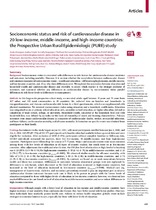| dc.contributor.author | Rosengren, Annika | |
| dc.contributor.author | Smyth, Andrew | |
| dc.contributor.author | Rangarajan, Sumathy | |
| dc.date.accessioned | 2021-06-30T07:46:07Z | |
| dc.date.available | 2021-06-30T07:46:07Z | |
| dc.date.issued | 2019 | |
| dc.identifier.citation | Rosengren et al. (2019). Socioeconomic status and risk of cardiovascular disease in 20 low-income, middle-income, and high-income countries: the Prospective Urban Rural Epidemiologic (PURE) study. The Lancet Global Health, 7(6), e748–e760. https://doi.org/10.1016/S2214-109X(19)30045-2 | en_US |
| dc.identifier.issn | 2214-109X | |
| dc.identifier.uri | https://doi.org/10.1016/S2214-109X(19)30045-2 | |
| dc.identifier.uri | http://hdl.handle.net/10566/6340 | |
| dc.description.abstract | ocioeconomic status is associated with differences in risk factors for cardiovascular disease incidence and outcomes, including mortality. However, it is unclear whether the associations between cardiovascular disease and common measures of socioeconomic status—wealth and education—differ among high-income, middle-income, and low-income countries, and, if so, why these differences exist. We explored the association between education and household wealth and cardiovascular disease and mortality to assess which marker is the stronger predictor of outcomes, and examined whether any differences in cardiovascular disease by socioeconomic status parallel differences in risk factor levels or differences in management. | en_US |
| dc.language.iso | en | en_US |
| dc.publisher | Elsevier | en_US |
| dc.subject | Socioeconomic status | en_US |
| dc.subject | Cardiovascular disease | en_US |
| dc.subject | Household wealth | en_US |
| dc.subject | Health issues | en_US |
| dc.title | Scioeconomic status and risk of cardiovascular disease in 20 low-income, middle-income, and high-income countries: The Prospective Urban Rural Epidemiologic (PURE) study | en_US |
| dc.type | Article | en_US |

